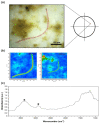Occurrence and Quantification of Natural and Microplastic Items in Urban Streams: The Case of Mugnone Creek (Florence, Italy)
- PMID: 35448420
- PMCID: PMC9025813
- DOI: 10.3390/toxics10040159
Occurrence and Quantification of Natural and Microplastic Items in Urban Streams: The Case of Mugnone Creek (Florence, Italy)
Abstract
The terrestrial environment is an important contributor of microplastics (MPs) to the oceans. Urban streams, strictly interwoven in the city network and to the MPs' terrestrial source, have a relevant impact on the MP budget of large rivers and, in turn, marine areas. We investigated the fluxes (items/day) of MPs and natural fibers of Mugnone Creek, a small stream crossing the highly urbanized landscape of Florence (Italy) and ending in the Arno River (and eventually to the Tyrrhenian Sea). Measurements were done in dry and wet seasons for two years (2019-2020); stream sediments were also collected in 2019. The highest loads of anthropogenic particles were observed in the 2019 wet season (109 items/day) at the creek outlet. The number of items in sediments increased from upstream (500 items/kg) to urban sites (1540 items/kg). Fibers were the dominant shape class; they were mostly cellulosic in composition. Among synthetic items, fragments of butadiene-styrene (SBR), indicative of tire wear, were observed. Domestic wastewater discharge and vehicular traffic are important sources of pollution for Mugnone Creek, especially during rain events. The study of small creeks is of pivotal importance to limit the availability of MPs in the environment.
Keywords: FTIR; Florence; fibers; microplastic; urban rivers.
Conflict of interest statement
The authors declare no conflict of interest.
Figures










Similar articles
-
Microplastic pollution in surface water and sediments in the urban section of the Vistula River (Poland).Sci Total Environ. 2021 Mar 25;762:143111. doi: 10.1016/j.scitotenv.2020.143111. Epub 2020 Oct 20. Sci Total Environ. 2021. PMID: 33131873
-
Environmental fate of microplastics in an urban river: Spatial distribution and seasonal variation.Environ Pollut. 2023 Apr 1;322:121227. doi: 10.1016/j.envpol.2023.121227. Epub 2023 Feb 7. Environ Pollut. 2023. PMID: 36758926
-
Occurrence and abundance of microplastics in surface water of Songkhla Lagoon.PeerJ. 2024 Jul 26;12:e17822. doi: 10.7717/peerj.17822. eCollection 2024. PeerJ. 2024. PMID: 39076778 Free PMC article.
-
Current research and perspective of microplastics (MPs) in soils (dusts), rivers (lakes), and marine environments in China.Ecotoxicol Environ Saf. 2020 Oct 1;202:110976. doi: 10.1016/j.ecoenv.2020.110976. Epub 2020 Jul 11. Ecotoxicol Environ Saf. 2020. PMID: 32800235 Review.
-
Microplastics in urban catchments: Review of sources, pathways, and entry into stormwater.Sci Total Environ. 2023 Feb 1;858(Pt 1):159781. doi: 10.1016/j.scitotenv.2022.159781. Epub 2022 Oct 26. Sci Total Environ. 2023. PMID: 36309285 Review.
Cited by
-
Simulation Study on the Optimisation of Replenishment of Landscape Water with Reclaimed Water Based on Transparency.Int J Environ Res Public Health. 2023 Feb 25;20(5):4141. doi: 10.3390/ijerph20054141. Int J Environ Res Public Health. 2023. PMID: 36901148 Free PMC article.
References
-
- Everard M., Moggridge H.L. Rediscovering the value of urban rivers. Urban Ecosyst. 2012;15:293–314. doi: 10.1007/s11252-011-0174-7. - DOI
-
- Walsh C.J., Roy A.H., Feminella J.W., Cottingham P.D., Groffman P.M., Morgan R.P. The urban stream syndrome: Current knowledge and the search for a cure. J. N. Am. Benthol. Soc. 2005;24:706–723. doi: 10.1899/04-028.1. - DOI
-
- Scholes L., Faulkner H., Tapsell S., Downward S. Urban rivers as pollutant sinks and sources: A public health concern for recreational river users? Water Air Soil Pollut. Focus. 2008;8:543–553. doi: 10.1007/s11267-008-9178-6. - DOI
-
- Harris A., Xanthos S.J., Galiotos J.K., Douvris C. Investigation of the metal content of sediments around the historically polluted Potomac River basin in Washington D.C., United States by inductively coupled plasma-optical emission spectroscopy (ICP-OES) Microchem. J. 2018;142:140–143. doi: 10.1016/j.microc.2018.06.033. - DOI
-
- Winsemius H.C., Jongman B., Veldkamp T.I.E., Hallegatte S., Bangalore M., Ward P.J. Disaster risk, climate change, and poverty: Assessing the global exposure of poor people to floods and droughts. Environ. Dev. Econ. 2018;23:328–348. doi: 10.1017/S1355770X17000444. - DOI
Grants and funding
LinkOut - more resources
Full Text Sources

